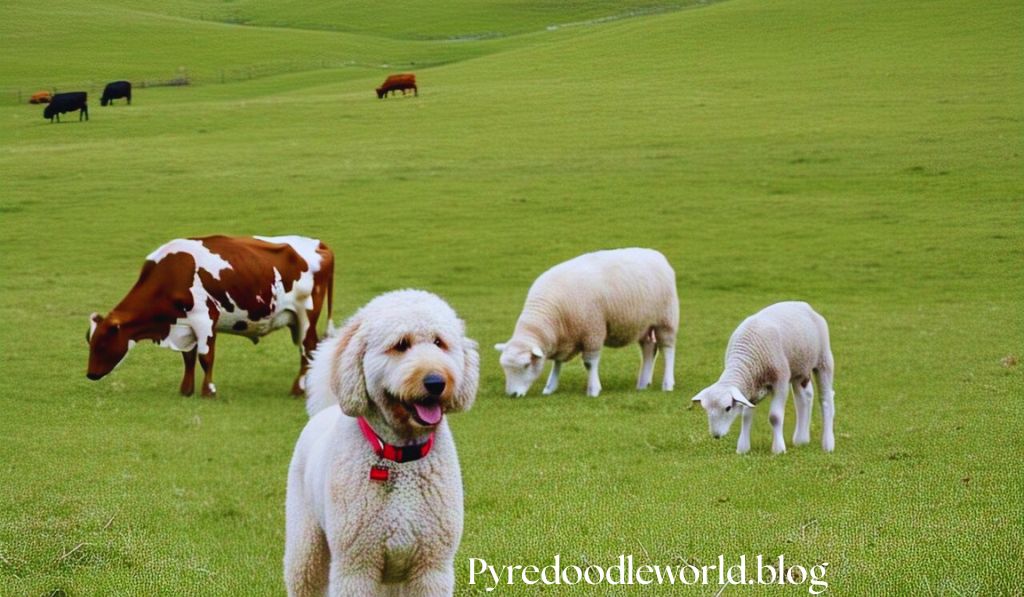Introduction
Pyredoodles are a remarkable designer dog breed, gaining popularity for their majestic appearance, loving temperament, and suitability for families.
A mix between the regal Great Pyrenees and the intelligent Standard Poodle, these gentle giants can quickly become the heart of any household. But one question often asked is: How big do Pyredoodles actually get?
Understanding the growth journey of a Pyredoodle is essential for providing them with the right care. From puppyhood to full maturity, these dogs undergo significant changes in size, behavior, and needs.
This comprehensive guide will explore how big Pyredoodles grow, the timeline of their development, the influencing factors, and how to manage their care at each stage. Whether you already own a Pyredoodle or are considering adopting one, this 6,000-word guide is your ultimate companion.
What Is a Pyredoodle?
A Pyredoodle is a crossbreed between a Great Pyrenees and a Standard Poodle. Both parent breeds bring a host of desirable traits to the mix.
The Great Pyrenees is known for its protective nature, loyalty, and calm demeanor. The Poodle, one of the most intelligent dog breeds, contributes hypoallergenic qualities, trainability, and energy.
Key characteristics of Pyredoodles include:
- Size: Medium-large to giant
- Coat: Wavy, curly, or straight; low to moderate shedding
- Lifespan: 10 to 12 years
- Temperament: Gentle, loyal, intelligent, protective
- Exercise needs: Moderate to high
- Compatibility: Great with families, children, and other pets when socialized early
The resulting hybrid is typically affectionate, calm indoors, and a fantastic companion for both urban and rural families.
Average Size of a Full-Grown Pyredoodle

The size of a full-grown Pyredoodle depends on several factors, primarily genetics. However, on average, you can expect the following:
| Type | Height (Shoulder) | Weight |
|---|---|---|
|
Standard Pyredoodle |
25 to 32 inches |
85 to 110+ pounds |
|
Mini Pyredoodle |
18 to 24 inches |
40 to 65 pounds |
These dogs are truly large — some male Pyredoodles may exceed 100 pounds. Their size is a significant factor to consider, especially for people living in apartments or homes with limited space. Despite their size, they are typically well-mannered and gentle.
Pyredoodle Growth Stages (With Timeline)
Just like humans, dogs grow in phases, and each phase presents unique challenges and care requirements. Let’s walk through the developmental timeline of a Pyredoodle.
1. Neonatal Stage (0–2 Weeks)

At birth, Pyredoodle puppies are completely dependent on their mother. Their eyes are shut, they can’t walk yet, and they need warmth and feeding every couple of hours. Their size is tiny, usually weighing just 1 to 2 pounds.
2. Transitional Stage (2–4 Weeks)
During this phase, the puppies begin opening their eyes and ears. They take their first steps and start to engage with their littermates. Physical growth starts picking up, and they may double in weight.

During this phase, the puppies begin opening their eyes and ears. They take their first steps and start to engage with their littermates. Physical growth starts picking up, and they may double in weight.
3. Socialization Period (4–12 Weeks)
This is a critical developmental window. Puppies become more aware of their surroundings, start interacting more actively, and begin learning basic canine behaviors. Weight ranges between 10 to 20 pounds depending on genetics.
4. Juvenile Stage (3–6 Months)
During this stage, puppies experience rapid growth in both height and weight. They lose their baby teeth and start teething. By the end of this phase, they could weigh 40 to 60 pounds.
5. Adolescent Stage (6–12 Months)
This phase marks the beginning of adolescence. Your dog might become lanky with long legs and an awkward gait. Energy levels spike, and behavioral changes may emerge. They could weigh between 70 to 90 pounds.
6. Adult Stage (12–24 Months)

By this stage, most Pyredoodles reach their full height but continue to gain muscle mass and body weight. A well-fed and well-exercised male Pyredoodle can weigh over 100 pounds, while females may average slightly less.
Growth Chart (Standard Pyredoodle)
| Age | Weight (Avg.) | Growth Notes |
|---|---|---|
|
8 Weeks |
15–20 lbs |
Puppy stage, very rapid growth |
| 3 Months | 30–40 lbs |
Start of socialization and basic training |
|
6 Months |
50–70 lbs |
Transition to adolescence |
|
9 Months |
70–85 lbs |
Majority of adult height reached |
|
12 Months |
85–95 lbs |
Adult height achieved, still bulking up |
|
18–24 Months |
90–110+ lbs |
Full physical and muscular maturity |
What Affects Pyredoodle Growth?

1. Genetics
This is the most critical factor. The size of the parent dogs has a strong influence on how big the puppy will grow. Puppies from larger parents will typically grow larger themselves.
2. Gender
Generally, male Pyredoodles are larger than females by about 10 to 15 pounds. Males also tend to be slightly taller and more muscular.
3. Nutrition
High-quality food tailored for large breeds is essential. Puppies need protein, fats, calcium, and phosphorus to grow strong bones and muscles. Malnutrition can lead to stunted growth or developmental issues.
4. Exercise
Appropriate physical activity helps support healthy growth and muscle development. However, over-exercising a growing puppy can harm their joints and bones.
5. Spay/Neuter Timing
Some evidence suggests that early spaying or neutering may affect growth patterns. Dogs neutered early often grow slightly taller due to delayed closure of growth plates but may have higher risks of joint disorders.
Feeding Guidelines
Feeding a growing Pyredoodle requires a well-planned diet. Avoid generic puppy foods — opt for large-breed specific formulas that cater to bone development and joint health.
|
Age |
Feeding Frequency | Diet Notes |
|---|---|---|
|
8–12 Weeks |
3–4 meals/day |
High-protein, high-calcium food |
|
3–6 Months |
3 meals/day |
Controlled fat intake to prevent obesity |
|
6–12 Months |
2–3 meals/day |
Maintain steady calorie intake |
| 12+ Months | 2 meals/day |
Transition to adult large-breed formula |
Avoid overfeeding and free-feeding, as obesity in large breeds can lead to severe joint and heart issues.
Grooming Considerations
Pyredoodles inherit a mix of coat types. Grooming requirements depend on whether their coat leans more toward the Poodle (curly and hypoallergenic) or the Great Pyrenees (straight and thick).
Typical grooming routine includes:
- Brushing: 3–5 times per week to prevent mats
- Bathing: Once every 4–6 weeks or as needed
- Trimming: Every 8–10 weeks for coat maintenance
- Nail care: Every 2–3 weeks
- Ear cleaning: Weekly, especially for floppy ears prone to infections
Regular grooming not only maintains coat health but also provides a bonding opportunity and helps detect any early skin issues.
Common Health Concerns in Large Dogs

Pyredoodles, like other large breeds, are prone to several health issues. Being aware of them helps you take preventive action.
- Hip and Elbow Dysplasia: Genetics and rapid growth contribute to this condition. Use joint supplements and maintain healthy weight.
- Bloat (Gastric Dilatation-Volvulus): A life-threatening condition that affects large-chested dogs. Feed smaller, frequent meals and avoid exercise immediately after eating.
- Eye Issues: Cataracts and progressive retinal atrophy can develop. Regular eye checks are recommended.
- Skin Sensitivities: Pyredoodles may suffer from allergies that affect the skin. Look out for redness, itchiness, or hot spots.
Behavioral Development & Training
Proper training is essential to ensure your large dog is manageable and well-behaved.
Basic Milestones:
- 8–12 weeks: Name recognition, potty training, crate training
- 3–6 months: Basic commands, leash walking, socialization
- 6–12 months: Reinforcement of training, impulse control
- 1–2 years: Advanced training and off-leash reliability
Consistency and positive reinforcement go a long way. Because of their size and strength, training is not optional — it’s essential.
Conclusion
So, how big do Pyredoodles get? The answer varies slightly based on genetics and gender, but you can expect a Standard Pyredoodle to grow up to 85–110+ pounds and 25–32 inches tall at the shoulder. Mini Pyredoodles are smaller but still medium-to-large in size.
Understanding the growth stages and how to care for your dog during each one ensures they live a long, healthy, and happy life.
By providing the right food, exercise, veterinary care, and training, your Pyredoodle will thrive and become a beloved member of your family.
From puppyhood to their senior years, Pyredoodles offer unwavering loyalty and affection. With proper preparation and knowledge, you’ll be equipped to meet the needs of this beautiful, gentle giant every step of the way.
Frequently Asked Questions (FAQs)
Q1: How big is a Pyredoodle at 6 months?
At 6 months, a Standard Pyredoodle typically weighs between 50 to 70 pounds and may be around 20–25 inches tall at the shoulder. They are rapidly growing during this stage and still have a lot of filling out to do.
Q2: Are Pyredoodles bigger than Goldendoodles?
Yes, in most cases, Standard Pyredoodles are larger than Standard Goldendoodles. Pyredoodles can exceed 100 pounds, while Goldendoodles usually top out around 70–80 pounds.
Q3: When do Pyredoodles stop growing?
Most Pyredoodles reach their full height by 12–18 months, but they may continue gaining weight and muscle mass until about 24 months of age.
Q4: Can apartment dwellers own a Pyredoodle?
It’s possible, but challenging. Pyredoodles need room to move around and benefit from a yard. If you’re in an apartment, daily long walks and exercise are a must.
Q5: Do Pyredoodles have a hypoallergenic coat?
It depends on which parent they take after. If they inherit more of the Poodle’s coat, they may shed less and be more allergy-friendly. However, no dog is completely hypoallergenic.
Q6: Are Pyredoodles good with children?
Yes, Pyredoodles are known for being gentle and patient with children, especially when socialized early. Always supervise interactions with younger kids due to the dog’s large size.
Q7: How much should I feed my adult Pyredoodle?
Adult Pyredoodles typically eat 3 to 4 cups of high-quality dog food per day, split into two meals. Always adjust based on your dog’s weight, activity level, and vet’s recommendations.
Q8: Do Pyredoodles need a lot of exercise?
They need moderate daily exercise. Long walks, play sessions, and mental stimulation help keep them healthy and happy.
Q9: Are Pyredoodles easy to train?
Yes, they are intelligent and respond well to positive reinforcement. Consistency and patience are key, especially during the adolescent phase.
Q10: How long do Pyredoodles live?
Pyredoodles generally have a lifespan of 10 to 12 years, though some may live longer with proper care, diet, and regular veterinary checkups.



